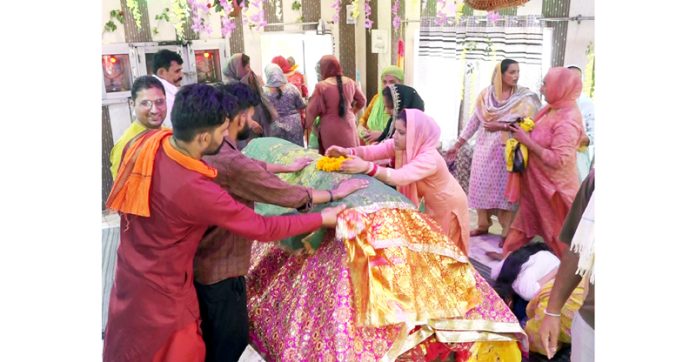Thousands of devotees throng Chamliyal mela on border
Amogh Rohmetra
Ramgarh, June 27: Close to 90,000 devotees thronged the annual Chamliyal mela at the 300-year-old shrine of Baba Dalip Singh Manhas, popularly known as Baba Chamliyal, on the India-Pakistan border in Samba’s Ramgarh today. However, the main crowd-puller of the fair— traditional exchange between Border Security Force (BSF) soldiers and Pakistani rangers— was absent for the seventh consecutive year.
Click here to connect with us on WhatsApp
Apart from Jammu and Kashmir, devotees came from Punjab, Haryana, Rajasthan and Himachal Pradesh.
As a tradition, prayers to the holy shrine are led by BSF every year by offering the first chadder at around 4 am. “Like every year, BSF was the first to offer chadder to Baba Chamliyal. We hope to continue this celebration every year,” Sanjeev Dhaiya, BSF Commandant of 148 Battalion said early in the morning outside the shrine while speaking to the media.
Click here to watch video
Until 2017, Pakistani rangers handed over a chadder to BSF soldiers to lay over the shrine. In reciprocation, the Indian side gave holy sand (known as shakkar) and water (known as sharbat) on tractors to be taken to the other side for devotees. While the fencing on the border and trees on the Pakistani side are visible a few metres away, the tradition’s absence continues to be felt by locals. Devotees believe that the holy sand and water have the power to cure skin diseases.
“Before 2018, the fair was different and now the fair is altogether different”, Vipin Choudhary declared on microphone, who makes regular announcements at the shrine. Choudhary is a member of Jai Baba Chamliyal (JBC) club, which comprises youth from nearby villages involved in the preparations for the event for about a month. “We used to have so many people before 2018 and this crowd is nothing in front of that. The ceremony used to be the main attraction and it drew a huge crowd”, said Choudhary from village Dakshini.
Kamal Kishore, another volunteer from a nearby village, gets a smile on his face when asked about the ceremony. “Wish that tradition could be started again”, says Kishore, who has been volunteering at the shrine since he was a kid.
A tradition spanning over seven decades since the partition, was suspended for the first time in 2018 amidst heightened tensions between the two nations following the killing of four BSF soldiers including an Assistant Commandant in ceasefire violation in the Chamliyal area days before the fair.
However, the remaining traditions continue till date. For one, the shrine continues to draw devotees across religions.
For many others the annual fair is the main attraction now. Huge swings are placed for kids along the 700 metre long road leading upto to the shrine. From fritters, sweets to shopping bags, toys, balloons in the temporary market, on now harvested fields, are also an attraction.
Billu Chowdhury, chairman of the management committee told Excelsior that though officially the fair happens only for a day on the fourth thursday of every June, “large numbers of people start coming one month prior”. In Pakistan too, the fair happens on the same day.
The district administration, in collaboration with BSF and Jai Baba Chamliyal management committee are at the forefront of organising the event.
The legend goes that Baba Chamliyal was highly respected among the nearby villages who lived in the late 17th or early 18th century. Some “anti-social” elements, who were unhappy with his popularity, called him to the village Saidawali in present day Sialkot, Pakistan. In Saidawali, 500 metres south of the shrine, baba is believed to have been beheaded. “But it is said that Baba’s body reached Chamliyal. Due to his spiritual power and feel at the present location”, according to the “brief history” at the shrine.


